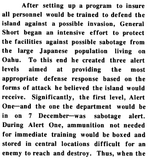Conslaw
Senior Airman
The Navy would not have abandoned Pearl Harbor. Hawaii defenses had already been strengthened by June 1942, and efforts were ongoing.
Even in December 1941, Japan was only able to achieve the results it did with more than a little bit of luck combined with the fact that the US was not completely on a wartime footing. Given the radar warning the US received, if it had been acted upon, and with the forces available at wartime readiness, the US could have met the oncoming air strike many miles out to see with about 100 US fighters. The ships would have either been undocked or covered by smoke-screens and torpedo nets. Antiaircraft guns would have been manned and ready. Any aircraft on the ground would have been in disbursed. The bottom line is that the Pearl Harbor raid could easily have cost the Japanese half of the attacking aircraft and achieved a fraction of the results.
If the radar warning at Pearl Harbor had been heeded, the air group losses by Japan could have been on the order of the losses at Coral Sea, rendering all six carriers combat ineffective even if the carriers themselves made it out unharmed.
Even in December 1941, Japan was only able to achieve the results it did with more than a little bit of luck combined with the fact that the US was not completely on a wartime footing. Given the radar warning the US received, if it had been acted upon, and with the forces available at wartime readiness, the US could have met the oncoming air strike many miles out to see with about 100 US fighters. The ships would have either been undocked or covered by smoke-screens and torpedo nets. Antiaircraft guns would have been manned and ready. Any aircraft on the ground would have been in disbursed. The bottom line is that the Pearl Harbor raid could easily have cost the Japanese half of the attacking aircraft and achieved a fraction of the results.
If the radar warning at Pearl Harbor had been heeded, the air group losses by Japan could have been on the order of the losses at Coral Sea, rendering all six carriers combat ineffective even if the carriers themselves made it out unharmed.

